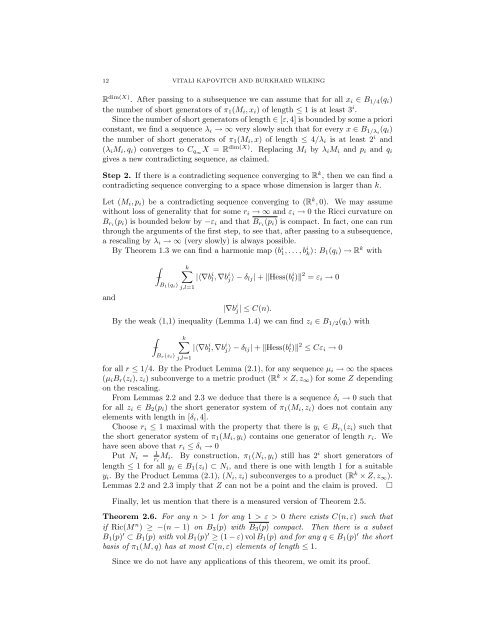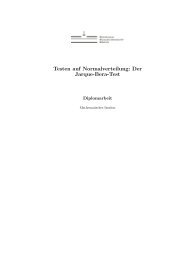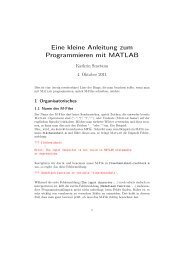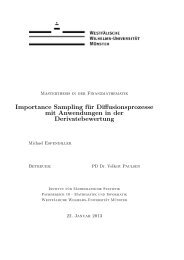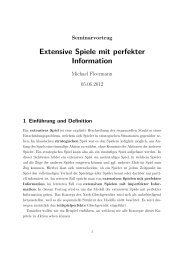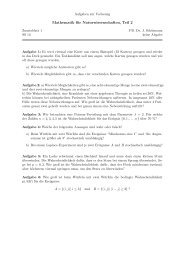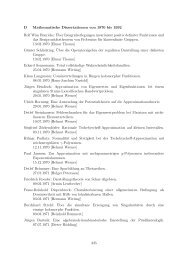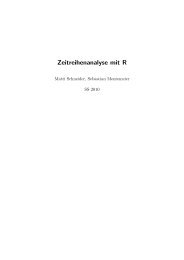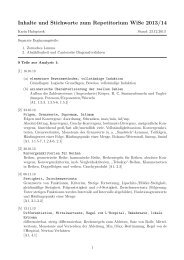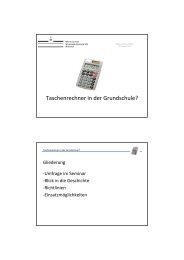Margulis Lemma
Margulis Lemma
Margulis Lemma
Create successful ePaper yourself
Turn your PDF publications into a flip-book with our unique Google optimized e-Paper software.
12 VITALI KAPOVITCH AND BURKHARD WILKING<br />
R dim(X) . After passing to a subsequence we can assume that for all x i ∈ B 1/4 (q i )<br />
the number of short generators of π 1 (M i , x i ) of length ≤ 1 is at least 3 i .<br />
Since the number of short generators of length ∈ [ε, 4] is bounded by some a priori<br />
constant, we find a sequence λ i → ∞ very slowly such that for every x ∈ B 1/λi (q i )<br />
the number of short generators of π 1 (M i , x) of length ≤ 4/λ i is at least 2 i and<br />
(λ i M i , q i ) converges to C q∞ X = R dim(X) . Replacing M i by λ i M i and p i and q i<br />
gives a new contradicting sequence, as claimed.<br />
Step 2. If there is a contradicting sequence converging to R k , then we can find a<br />
contradicting sequence converging to a space whose dimension is larger than k.<br />
Let (M i , p i ) be a contradicting sequence converging to (R k , 0). We may assume<br />
without loss of generality that for some r i → ∞ and ε i → 0 the Ricci curvature on<br />
B ri (p i ) is bounded below by −ε i and that B ri (p i ) is compact. In fact, one can run<br />
through the arguments of the first step, to see that, after passing to a subsequence,<br />
a rescaling by λ i → ∞ (very slowly) is always possible.<br />
By Theorem 1.3 we can find a harmonic map (b i 1, . . . , b i k ): B 1(q i ) → R k with<br />
and<br />
∫<br />
−<br />
B 1(q i)<br />
j,l=1<br />
k∑<br />
|〈∇b i l, ∇b i j〉 − δ lj | + ‖Hess(b i l)‖ 2 = ε i → 0<br />
|∇b i j| ≤ C(n).<br />
By the weak (1,1) inequality (<strong>Lemma</strong> 1.4) we can find z i ∈ B 1/2 (q i ) with<br />
∫<br />
−<br />
B r(z i)<br />
j,l=1<br />
k∑<br />
|〈∇b i l, ∇b i j〉 − δ lj | + ‖Hess(b i l)‖ 2 ≤ Cε i → 0<br />
for all r ≤ 1/4. By the Product <strong>Lemma</strong> (2.1), for any sequence µ i → ∞ the spaces<br />
(µ i B r (z i ), z i ) subconverge to a metric product (R k × Z, z ∞ ) for some Z depending<br />
on the rescaling.<br />
From <strong>Lemma</strong>s 2.2 and 2.3 we deduce that there is a sequence δ i → 0 such that<br />
for all z i ∈ B 2 (p i ) the short generator system of π 1 (M i , z i ) does not contain any<br />
elements with length in [δ i , 4].<br />
Choose r i ≤ 1 maximal with the property that there is y i ∈ B ri (z i ) such that<br />
the short generator system of π 1 (M i , y i ) contains one generator of length r i . We<br />
have seen above that r i ≤ δ i → 0<br />
Put N i = 1 r i<br />
M i . By construction, π 1 (N i , y i ) still has 2 i short generators of<br />
length ≤ 1 for all y i ∈ B 1 (z i ) ⊂ N i , and there is one with length 1 for a suitable<br />
y i . By the Product <strong>Lemma</strong> (2.1), (N i , z i ) subconverges to a product (R k × Z, z ∞ ).<br />
<strong>Lemma</strong>s 2.2 and 2.3 imply that Z can not be a point and the claim is proved. □<br />
Finally, let us mention that there is a measured version of Theorem 2.5.<br />
Theorem 2.6. For any n > 1 for any 1 > ε > 0 there exists C(n, ε) such that<br />
if Ric(M n ) ≥ −(n − 1) on B 3 (p) with B 3 (p) compact. Then there is a subset<br />
B 1 (p) ′ ⊂ B 1 (p) with vol B 1 (p) ′ ≥ (1 − ε) vol B 1 (p) and for any q ∈ B 1 (p) ′ the short<br />
basis of π 1 (M, q) has at most C(n, ε) elements of length ≤ 1.<br />
Since we do not have any applications of this theorem, we omit its proof.


